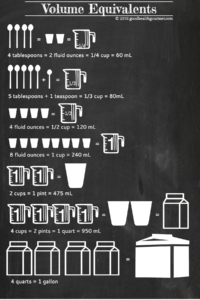MEASUREMENTS
People sometimes don’t realize that math plays an important role in the kitchen. Ratios, fractions and calculations all come into play, particularly when you’re writing a recipe or scaling one to produce a different quantity. To complicate things further, units of measure vary depending on where you live. Here in the U.S. we use what’s known as the imperial system, while practically every other country in the entire world (except for Liberia and Myanmar) relies on the much more sensible metric system. Unfortunately this means that everything from ingredient package sizes to recipe quantities to temperature scales is different. It’s enough to make your head spin! Since I’m based in the U.S. and I grew up using the imperial system, that’s what I automatically default to when I’m developing a recipe. For those of you who use the metric system I’ve created handy little tables that will help you convert quantities to your units of measure or look up common equivalents. I hope you find them useful.
Calculations for Metric Conversions
Common Metric and Imperial Weight Equivalents
When using the imperial system it helps to know the equivalents for volume measurements, for example how many teaspoons there are in a tablespoon, how many tablespoons there are in a cup, and so on. If you’re a geek like me with a head for numbers and you spend most of your time in the kitchen, you may already have this stuff memorized. If not, here’s a simple infographic I created to make it easy to understand (I’ve included some metric values in there as well). Feel free to print it out and tack it up in your kitchen somewhere for quick reference…
For those of you who prefer tables to pictures, here you go…
Dry Measures
Liquid Measures
Regardless of which system you use, you’ll often see measurements abbreviated in recipes. Just in case you’re not sure what all the abbreviations stand for, here’s a cheat sheet:
I think that about covers it for basic measurements. If I missed anything you’d like to see here, please let me know!










 Crisp edges
Crisp edges 










